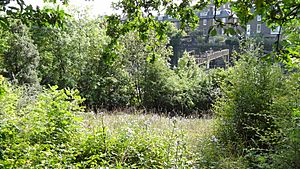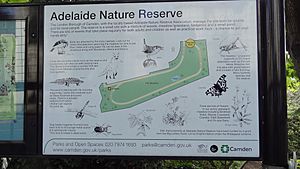Adelaide Nature Reserve facts for kids
The Adelaide Local Nature Reserve is a special green space in North West London. You can find it near areas like Chalk Farm, Primrose Hill, Belsize Park, and Swiss Cottage. It's looked after by a group of local volunteers called the Adelaide Nature Reserve Association. They work with the local council to make the area great for wildlife and for people to enjoy. This place is so important for nature that it's officially a Local Nature Reserve and a top-rated Site of Borough Importance for Nature Conservation.
Contents
A Look Back: History of the Reserve
This nature reserve has been a protected area since 1984. But for hundreds of years before that, it was a hay meadow. This means it grew grass that was cut to feed London's horses!
In the 1800s, a railway was built right through this area. You can still see Stephenson's railway tunnel nearby. When it was finished in 1837, it was considered one of the most amazing engineering projects in the world!
Later, in the 1900s, before World War Two, the land was covered with people's home gardens. There was even a tree nursery here at one point. The reserve was started by Ursula Granville, and there's a special plaque to remember her.
The land actually belongs to Network Rail, which is the company that manages railway lines. They let the London Borough of Camden use it as a nature reserve. It has been managed for nature since 1985 and officially became a Local Nature Reserve in 2011.
What You Can See and Do at the Reserve
The reserve has a sunny meadow that faces south, along with some wooded areas. There are also two ponds, and one has a platform where you can try pond dipping to see what creatures live in the water! A path goes all the way around the site, perfect for a walk.
You'll also see a cool mural (a large painting on a wall) that shows pictures of the wildlife found at the reserve. Because the land is quite steep, it's not easy for wheelchairs to access the paths.
You can enter the reserve from Adelaide Road, which is east of Primrose Hill Road. The reserve is usually open to the public on Saturdays and Sundays.
Fun Activities and Events
The volunteers often hold special events on the last Sunday of each month, from 11 AM to 3 PM. They also have activities at other times if you arrange it.
Some of the fun things people have done here include:
- Looking for and counting birds and plants.
- Going on nature trails to explore.
- Making wildlife-themed arts and crafts.
- Creating badges.
- Playing nature quizzes and games.
Many different groups, like Green Gym, University College London, and Interact, have helped out as volunteers at the reserve.
Amazing Wildlife at Adelaide Reserve
This nature reserve is home to a wide variety of animals, insects, and plants!
Insects: Tiny Creatures, Big Discoveries
Scientists have found many interesting insects here, including some rare solitary wasps. The reserve is also known for its many types of grasshoppers and crickets.
One of the most exciting finds was a rare type of chafer beetle. This beetle hadn't been seen in Britain since the 1950s! You can also find lesser stag beetles here, and volunteers are trying to attract the even bigger Great stag beetle by building "loggeries" – piles of logs. Volunteers leave logs around because they make great homes for insects and fungi.
A special "insect house" has been built to give insects like ladybirds, lacewings, and butterflies a warm place to stay in winter. There are also special boxes for bees to nest in.
You can spot many beautiful butterflies, including Peacock, Comma, Meadow brown, Small heath, Small skipper, Essex skipper, Green veined, Large and Small white, Small copper, Brimstone, Holly blue, Common blue, Speckled wood, and Gatekeeper. Some moths, like the Narrow-bordered Beehawk moth and Burnet moth, have also been seen.
A new insect that has arrived, which isn't so welcome, is the Harlequin ladybird. It can be a threat to the native ladybird species. A really cool new arrival in recent years has been the Wasp spider, which looks a bit like a wasp! You might also see distinctive mounds in the meadow made by Yellow meadow ants.
Birds: Feathered Friends
Volunteers regularly count the birds at the reserve. A Green woodpecker has been seen hunting for ants in the meadow. Common birds that visit often include Great, Blue, and Long-tailed tits, Robin, Wren, Blackcap, Carrion crow, Jay, Magpie, and Blackbird.
A more unusual visitor was a Meadow pipit. You might even see a Red kite or a Sparrowhawk flying high overhead!
There's a bird-feeding station where you can get a good look at the birds. Many bird boxes have been put up around the reserve, and Blue tits have used them to build their nests.
Animals: Mammals and More
Foxes have made their dens (homes) in the reserve, and local people often see them. Volunteers have also made special boxes for hedgehogs to hibernate (sleep through winter) in, keeping them warm and dry. Squirrels are often seen climbing high in the trees. The pond is home to a group of newts, which are small amphibians.
Plants: A Green Wonderland
The meadow area is full of different kinds of plants. Some of the plants recently seen include Birdsfoot trefoil, Bloody cranesbill, Corncockle, Cowslip, Dog rose, Evening primrose, Field speedwell, Lesser periwinkle, Michaelmas daisy, Oxeye daisy, Vipers bugloss, Sweet violet, Lucerne, Wild gladiolus, Green alkanet, Herb robert, Lesser celandine, Marsh marigold, Purple loosestrife, Yellow flag, Wild strawberry, and Yarrow. Some of these plants were planted by people, while others grew there naturally.
Trees & Shrubs: The Green Giants
The reserve has many different types of trees, including English oak, Caucasian oak, Turkey oak, Holm oak, and Sessile oak. You can also find Rowan, Ash, Lime, Spindle, Hazel, Laburnum, Apple, Cotoneaster, Hawthorn, and Silver birch.
Plant Galls: Nature's Bumps and Lumps
The reserve has a good variety of plant galls, which are strange bumps or growths found on plants. These galls are often caused by tiny insects, like wasps or mites, that lay their eggs or feed on the plant, causing it to grow in an unusual way. Some of the galls here are quite rare!
For example, on oak trees, you might find "Hedgehog gall" or "Ramshorn gall," which are caused by wasps. The well-known Robin’s pincushion gall, which is caused by a wasp on Dog rose plants, can also be found here sometimes. These galls are a fascinating example of how insects and plants interact in nature.



